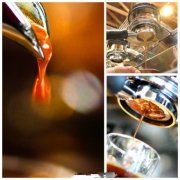High-quality coffee tasting technology coffee cup test and sharing
Whenever you get a bag of untasted coffee beans, the coffee cup tester will taste them in the following ways. Of course, this practice is not necessarily the most ideal, or meets some industry standards, it's just my personal taste style (tasting profile)! The purpose of tasting is for research and learning, and if you are not in the coffee industry, this method may not be suitable for you.

My tasting process consists of two parts: "immersion extraction (steep extraction)" and "Italian concentration (espresso)".
Test environment for immersion extraction
"soak extraction" can be said to be the sashimi of coffee beans, direct, stable, unprocessed, can almost completely rule out the impact of cooking technology, and the important thing is: the equipment is simple, portable and portable! I usually use Aibei Smart filter Cup (Abid Dripper) with Hario MCD3SV metal filter, which is a simple and easy-to-use combination with satisfactory results! Use a pressure kettle (french press) or a cup test (cupping) when going out.
When using Abid Dripper + Hario MCD3SV metal strainer, my test environment data are as follows: two flat tablespoons of coffee beans (European coffee spoon, about 14-16g), medium grinding, injection of 200F hot water 250ml, soaking for two minutes, stirring three times during soaking, and pouring into a white ceramic cup after soaking.
When performing these steps, I will observe and record the following information at the same time:
A) appearance of coffee beans, degree of roasting (Agtron number before grinding), smell of coffee beans (pre-grinding)
B) dry aroma, coffee powder color (Agtron number after grinding)
C) Wet aroma
D) Coffee color
E) Cup test record
Italian concentrated test environment
As we all know, brewing espresso has many variables and has a great impact on the performance of the cup. However, a cup of proper espresso also conveys the most information, which can magnify the flavor, characteristics, taste, advantages and disadvantages of a type of coffee beans, so that they can be easily inspected.
The top priority of espresso testing is a stable test environment. Thanks to Synesso Cyncra, thanks to this excellent machine, the stability problem has been half solved. At least, the stability of the combination of Synesso Cyncra accurate temperature control in 0.1 degrees Fahrenheit in units of Fahrenheit and bean grinder Mazzer Robur with tapered knife head can be trusted. As for the "filling pressure", another important link that has a great impact on stability, when testing coffee beans, I will use the fixed pressure auxiliary filler Press Point Espresso Tamper instead of manual filling, in order to reduce the variables of filling action.
What is worth mentioning is the standard of cooking water temperature. My benchmark water temperature is as follows: medium and shallow roasting coffee beans use 200F and 203.5F, both of which are tried and then adjusted; deep-roasted coffee beans use 197F first, and then fine-tune their performance. Chongqing Brista Coffee West Point training School
As for the dose and filter, I used the original Synesso handle to refit the bare handle (NPF), Double filter, put 17 grams of powder, 30 seconds from 25 to 60 cc. If the situation permits (sample beans and sufficient time), adjust the size of the filter and the amount of powder according to its characteristics and performance. In addition, the unavoidable action of preparing before cooking is to change the water and release the water from each boiler in the Synesso Cyncra and replace it with fresh water. This step is very important.
Notes for coffee tasting:
1. The test time is in the morning, and the morning with plenty of sunshine is the best time.
two。 Try to avoid tasting coffee beans that are too fresh (within three days of baking). For Italian coffee beans, the best testing time is about one week after baking (deep roasting) to two weeks (medium and shallow roasting).
3. Only use coffee cups with white interior.
4. Coffee is not judged by the results of a single test (or several times). Repeat testing the same coffee beans as often as possible.
Important Notice :
前街咖啡 FrontStreet Coffee has moved to new addredd:
FrontStreet Coffee Address: 315,Donghua East Road,GuangZhou
Tel:020 38364473
- Prev

High-quality coffee encyclopedia knowledge of what is fine coffee
In recent years, the most popular key word in Chinese coffee industry must be boutique coffee. Coffee practitioners must talk about high-quality products, but coffee lovers are mostly ignorant of boutique coffee. What is boutique coffee? What is fine coffee? What is the taste of boutique coffee? When I am asked too many questions, I have an impulse to talk to everyone, so I
- Next

Coffee beans common sense how to tell the true from the fake Kopi Luwak
Today, I heard a friend talk about civet coffee beans? Chongqing Brista Coffee West Point College is here to popularize how to identify the real Kopi Luwak! There are two kinds of animals on the market that produce Kopi Luwak, masked palm civet and civet! So are masked palm civet and civet the same animal? In this affirmative answer, the two are not the same animal, although both belong to the cat family, but masked palm civet only smelly glands, and musk deer
Related
- Beginners will see the "Coffee pull flower" guide!
- What is the difference between ice blog purified milk and ordinary milk coffee?
- Why is the Philippines the largest producer of crops in Liberia?
- For coffee extraction, should the fine powder be retained?
- How does extracted espresso fill pressed powder? How much strength does it take to press the powder?
- How to make jasmine cold extract coffee? Is the jasmine + latte good?
- Will this little toy really make the coffee taste better? How does Lily Drip affect coffee extraction?
- Will the action of slapping the filter cup also affect coffee extraction?
- What's the difference between powder-to-water ratio and powder-to-liquid ratio?
- What is the Ethiopian local species? What does it have to do with Heirloom native species?

